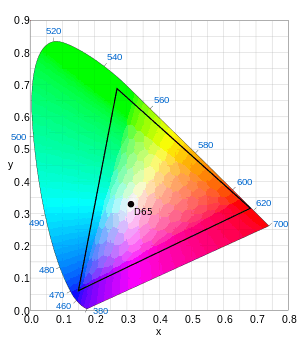DCI-P3

DCI-P3, or DCI/P3, is a common color space for digital movie projection from the US-American film industry.[1] It covers most of the range of naturally occurring surface colors (after Michael R. Pointer, 1980;[2] 85.5% in CIE 1931, 86.9% in CIE 1976 u’v’) with the most distinct drawbacks in the green-blue range. The covered area in the range of colors perceptible for humans (CIE 1931: 45.5%, CIE 1976: 41.7%) is equally great in the CIE 1931 color space as with the Adobe RGB color space (45.2%, 38.7%), albeit slightly shifted towards red.[3] The blue primary color is the same as sRGB and Adobe RGB;[1] the red primary color is a monochromatic light source and has a wavelength of 615 nm. DCI-P3 was defined by the Digital Cinema Initiatives (DCI) organization and published by the Society of Motion Picture and Television Engineers (SMPTE) in SMPTE EG 432-1 and SMPTE RP 431-2.[4] As a step towards the implementation of the significantly wider Rec. 2020 it is expected to see adoption in television systems and in the home cinema domain.[5]
History
On November 10, 2010, SMPTE published SMPTE EG 432-1:2010.[6]
On April 6, 2011, SMPTE published SMPTE RP 431-2:2011.[7]
On January 4, 2016, the UHD Alliance announced their specifications for Ultra HD Premium which requires devices to display at least 90% of the DCI P3 color space.[8][9]
In September 2015, Apple's iMac desktop became the first consumer computer with a built-in wide-gamut display, supporting the P3 color space.
In September 2016, Apple's iPhone 7 shipped with a wide-gamut display, supporting P3.[10]
In October 2016, Microsoft's new Surface Studio desktop computer and Apple's new MacBook Pro notebook computer were released with P3 displays.
System colorimetry
| Color space | White point | Primary colors | ||||||
|---|---|---|---|---|---|---|---|---|
| xW | yW | xR | yR | xG | yG | xB | yB | |
| DCI-P3 D65 | 0.3127 | 0.3290 | 0.680 | 0.320 | 0.265 | 0.690 | 0.150 | 0.060 |
| DCI-P3 Theater | 0.314 | 0.351 | 0.680 | 0.320 | 0.265 | 0.690 | 0.150 | 0.060 |
DCI-P3 has a 25% larger Color Gamut than sRGB.[13]
References
- 1 2 "Color spaces". Technicolor SA. Retrieved 2016-02-01.
- ↑ Michael R. Pointer (1980-09-01). "The Gamut of Real Surface Colours". 5 (3). Color Research & Application: 145–155. doi:10.1002/col.5080050308. ISSN 1520-6378. Retrieved 2016-02-01.
- ↑ Jeff Yurek (2013-07-23). "How much color gamut do displays really need? Part 3: Existing color gamut standards". dot color. Retrieved 2016-02-01.
- ↑ The Society of Motion Picture and Television Engineers, 2011, New York: RP 431-2, D-Cinema Quality – Reference Projector and Environment for the Display of DCDM in Review Rooms and Theaters
- ↑ Geoffrey Morrison (2015-04-12). "Ultra HD 4K TV color, part II: The (near) future". CNET. Retrieved 2016-02-01.
- ↑ "EG 432-1:2010 - Digital Source Processing — Color Processing for D-Cinema". Institute of Electrical and Electronics Engineers. 2010-11-10. Retrieved 2016-02-01.
- ↑ "RP 431-2:2011 - D-Cinema Quality — Reference Projector and Environment". Institute of Electrical and Electronics Engineers. 2011-04-06. Retrieved 2016-02-01.
- ↑ "UHD Alliance Defines Premium Home Entertainment Experience". Business Wire. 2016-01-04. Retrieved 2016-02-01.
- ↑ Andy Vandervell (2016-01-06). "What is Ultra HD Premium? New HDR standard explained". TrustedReviews. Time Inc. UK. Retrieved 2016-09-19.
- ↑ Mike Wuerthele (2016-09-09). "Apple's Wide Color screen on the iPhone 7 will lead to more faithful color reproduction". AppleInsider. Retrieved 2016-09-19.
- ↑ Kid Jansen. "The Pointer's Gamut". TFT Central. Retrieved 2016-01-30.
- ↑ Rajan Joshi; Shan Liu; Gary Sullivan; Gerhard Tech; Ye-Kui Wang; Jizheng Xu; Yan Ye (2016-01-31). "HEVC Screen Content Coding Draft Text 5". JCT-VC. Retrieved 2016-01-31.
- ↑ Dean Jackson (2016-07-01). "Improving Color on the Web". WebKit. Retrieved 2016-09-19.